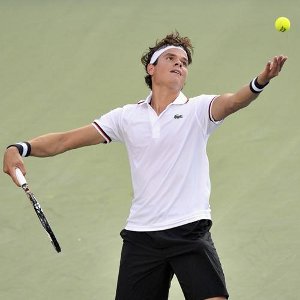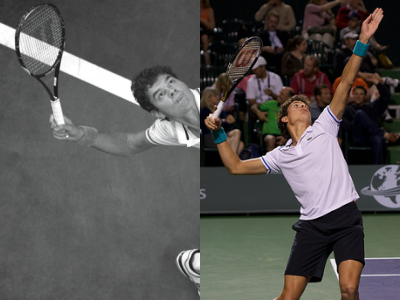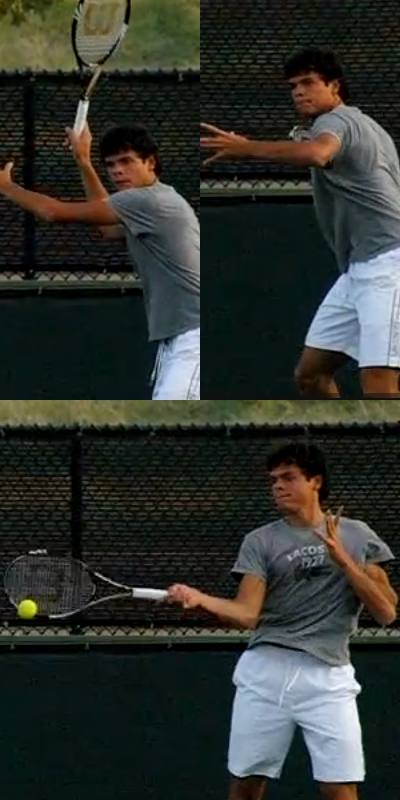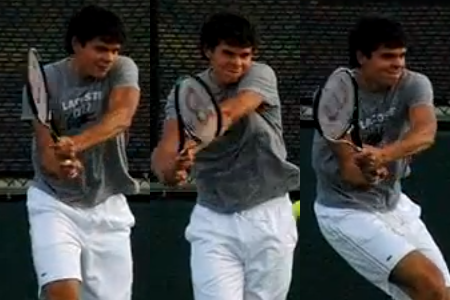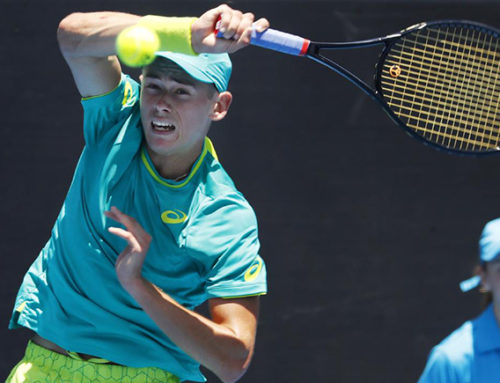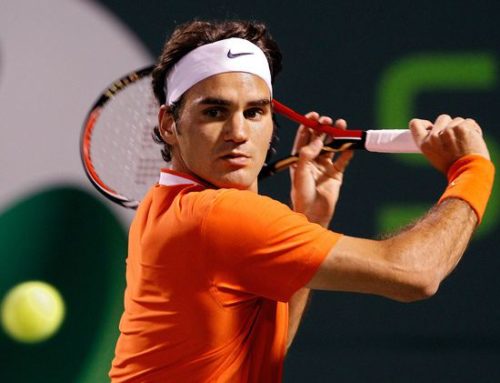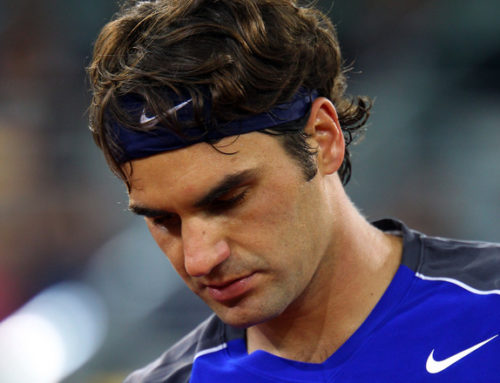Survival of the fittest decrees those organisms best suited to adapt to their environment stand the best chance of survival. In other words, become too specialized and you risk becoming obsolete. Traditionally skewing taller than the average population, professional tennis has generally selected against those who lie too far outside the norms when it comes to height. In the open era the list of champions whose height falls between 5’11 and 6’1 is long indeed, and for many years 6’1 was in fact deemed the perfect height for the sport. Too short, and you lose valuable height at contact on the serve, have poor reach at the net and lack leverage. Too tall and you become a lumbering leviathan, slow and ponderous around the court and vulnerable on the move. History has shown us that mobility is a critical element in tennis greatness, and the link between size and mobility tends to hold true. In the history of the game, every single player to have spent more than 50 weeks at #1 was 6’2 or below. And in the history of the game, no player taller than 6’3 has spent 10 weeks total at the #1 ranking spot. Those are damning numbers for the big men.
But things are changing – the last five years has seen the rise of more and more players who are gigantic by old standards yet have surprisingly mobility. Berdych, Del Potro, Cilic and Raonic are all in the top 20, all stand 6’5 or above, and all are surprisingly mobile big men. However mobility is all relative, and all four of them play a particular style of play generally termed ‘big man tennis’ – a general strategy of dictating play behind a big serve from the middle of the court, and keeping the points short. Today we will take an in depth look at Milos Raonic, the young Canadian who has climbed steadily up the rankings behind a monstrously good serve to a career high of #13. He heads into this month’s Australian Open hoping to make a mark following a 4th round appearance at the US Open last year.
Background
It might come as no surprise that a man named Milos Raonic is not fifth-generation Canadian. Raonic was born in Yugoslavia and moved with his family to Canada when he was three. This was a fortunate even for Canadian tennis, as with his career high of 13 last year, Raonic became the highest ranked Canadian player in the history of the open rankings. It is interesting that Raonic had relatively little junior success. While junior slam wins are no predictor of success at the pro level (hold up your hand if you’ve ever heard of Roman Valent) it is rare for a budding young player to do so poorly in these events and reach the heights that Raonic has – he bombed out in the first or second round in all three of the junior slams he partook in (all in 2008). He concentrated on building his career in Futures events, and got his breakthrough in 2009 when he won his first event. Although his rise hasn’t been meteoric, it has been steady. Perhaps he took time to mature into his current 6’5, 200lb frame. Regardless he is hoping to make his mark in the majors in his third year of grand slam tennis. Let’s take a look at the tools he will use to do so.
Serve
We might argue about who has the greatest serve in the history of the game, but one thing is certain – Raonic has the biggest serve on tour at present. Throwing down over 1000 aces in 2012 alone, Raonic leads the tour in first serve % won (82%), % break points saved (74%), and service games held (93%). Those are, quite frankly, astounding numbers. So how do his serve mechanics look?
While generally a pretty clean motion, Raonic does have one or two oddities. The first, and most obvious, is his wrist position. Holding a fairly strong continental grip (with the heel of the palm shifted towards an eastern backhand grip) Raonic takes his racket back with his wrist in an exaggeratedly cocked position (as evidenced in the picture above). He brings the racket up somewhat more to the side than most players, but rotates his shoulders back into a strong trophy position in a platform stance. The only slight oddity is, again, the wrist position as seen below.
The wrist is a minor thing, perhaps even purely aesthetic. He is clearly still able to drop the racket head down his back and accelerate up at the ball without issue. His velocity typically tops out in the low 140’s during a match with his average first serve speed in the mid to high 120’s. Raonic’s first serve % hangs in the low 60’s in most matches (he average 63% in 2012). He aims mostly for the corners – body serves are a rarity for Raonic despite his velocity – and he tends to split his delivery location evenly between the T and the wide serve, although he will make minor adjustments depending on his opponent.
Raonic’s second serve comes in at very respectable velocity – typically between 100 and 110 mph. He uses a good number of body serves on the second serve – as much as 60% depending on the match. Raonic also backs it up well – he came in 8th on the tour in 2012 in second serve % won – a mere 1% behind Nadal who was in second place at 57%. His second serve is imposing, but not overpowering so he is certainly doing something right in backing it up. So what exactly does Milos Raonic back his serve up with?
Groundstrokes
Raonic bears any similarities to Del Potro – no coincidence since they are both big men with mediocre mobility. Both hit a very flat, penetrating ball off the forehand side, although generally Del Potro’s technique is definitively better. We’ll start by having a look at a couple of key positions in Raonic’s forehand.
The first thing to note is the very high take-back. Raonic’s hand is up at head height, with the racket-head comfortably above that. This higher take-back is a common feature on taller players – Berdych, Del Potro and Raonic are just three quick examples of 6’5+ players whose hands are extremely high on the take-back – and contributes to the flatter ball that is also a common feature with the big guys. From the first position, you can see Raonic dropping into a relatively common position with top pros with the right hand not breaking the plane of the hips. The last position, at contact, shows the bent arm which is one point of significant deviation from, say Del Potro or Federer. This bent arm position sacrifices racket-head speed and doesn’t allow for the same smooth closing of the racket face through contact.
So what does all this mean in terms of Raonic’s ability to hit a forehand in match play? The big, elevated backswing and good shoulder turn combined with his sheer size significant racket-head speed despite his bent arm at contact. He has a shallow angle-of-attack on the ball which means he hits it hard and flat with comparatively little topspin. In short his forehand is a weapon, but not a versatile one. He doesn’t have the range of someone like Federer (but then again, who does?). It is a classic big-man forehand. High risk, high reward. He uses his huge serve to get forehands as frequently as possible for the first ball, and uses that forehand to try and dictate play. He is capable of playing angles with it – watch him play and you’ll see he isn’t afraid to take it off the court from forward positions – but his margins are small. The effect of these narrowed margins are visible in his unforced error count. The significant size of his backswing also contributes – it is possible for other big hitters or players who take the ball early to rush him off the forehand wing and either draw errors or lower-quality responses.
Raonic’s backhand is solid without being spectacular. It is a fairly compact stroke, and not the major source of errors (his forehand takes care of that). It is in most regards a fairly typical two-handed backhand with only one thing worth noting, particularly as it is in regards to his movement. The image below shows Raonic’s backhand immediately after contact on three different shots:
The first was a slight off-center topspin shot – essentially topspin with a fair amount of sidespin added in. This was hit off a ball that was deep in the court, and which he took on the rise a little off his back foot. The second image is from a ball he had plenty of time on, and got straight topspin on. The third is a ball he hit on the stretch, and had essentially pure sidespin on it. The key thing to take away from these three images is that the quality of Raonic’s backhand, like most of his shots, is impacted by the amount of movement and his positioning. Unlike the true elite (Djokovic, Nadal, Murray, Federer) who continue to hit their high-quality ball on the dead run or even off-balance, Raonic needs to be in good court position and balanced to play his best tennis. This makes it difficult for him to transition from defense to offence, and serves to stress how important it is for him to be in control of the point whenever possible.
His defense isn’t bad for his size. He has a serviceable slice backhand, and plays the squash forehand shot well also. However once he gets on defense it takes a let-up from his opponent for him to truly get back in the point. I’ve seen him play where he stayed on defense for 5, 6 or 7 shots straight – something you almost never see the top players do (excepting Monfils, who finds ways to be on defense against everyone).
Volleys
Raonic has solid volleys – his technique is good without being exceptional. His touch is a little on the rough side on the low balls, especially on the half-volley. It is less his actual volleying technique than his movement at net which causes him trouble. His agility is sub-par and it becomes significantly more apparent in his net play than at the baseline where that critical extra 300-500 milliseconds make all of the difference. He is slow to change direction, and lacks true explosiveness on his first step. It is here that he begins to truly look like the lumbering giant described in the opening paragraph – at times he looks downright clumsy in the forecourt.
Tactics
Raonic doesn’t suffer from a confused identity as a player. By and large he understands his strengths and weaknesses and does a respectable job of playing to them appropriately. He brings a huge first serve to the court and a flat and penetrating ground game. He is quick to move forward and press play, keeping the points short and dynamic. Raonic will serve and volley sometimes but it is far from his dominant play. A typical Raonic point on serve involves a big serve, followed by two forehands – after which most points are over one way or the other. He does vary the amount he moves forward somewhat – against Murray in the US Open last year he came forward a staggering (for 2012 anyway) 38 times in 3 sets. In his 3 set win earlier that same tournament against James Blake his net approaches numbered 25, but in his five-set victory in the first round he came in just 21 times in 5 sets. That’s a lot of variation, and suggests he is either consciously adjusting his net approaches for tactical reasons, or he comes to net under relatively consistent conditions and the numbers vary based on how many opportunities his opponents give him. If pressed, the latter rather than the former seems to be the case here.
So what can he do better? More than anything, Raonic needs to make better choices about when he is coming forward to the net. It isn’t the amount that he’s doing so – given his game I expect him to be making a move forward within 2-5 shots almost every point. The issue right now is that he often does so off the wrong ball or, even worse, does so off the right ball by hitting into the wrong place. One thing Raonic needs to learn is the danger of providing angle for your opponent – he is too often suckered into approaching into the open court, and in doing so plays himself out of position. This is exacerbated by his movement, and results in him getting passed far too often for a guy of his size and competent volleying skill. Raonic must adjust, hit more approach shots either down the line or directly at his opponent and handcuff them – close the net well and use his sheer size and reach to force opponents into thinner margins on their passing shots.
2013 Outlook
At present Raonic doesn’t have the tools needed to truly threaten the elite. He might beat one of them on any given day – his ability to hold serve is astounding and not to be discounted. However he lacks the depth of game at present to be a constant threat. He is in many ways the worst type of player to make predictions for – capable of beating anybody on a given day, he is the type of dangerous ‘floater’ that most top seeds dread. However it becomes easier when we take the long view. 2013 will be a year of consolidation for Raonic. He might break into the top 10 this season, but I would not expect him to make a permanent place for himself there – yet. He will run deep in some tournaments, but bounce surprisingly early from others to relative unknowns on days when he struggles with his groundstrokes. This is a year where he will begin to further his understanding of the game – perhaps improve his decision-making skills regarding his net approaches. He is on the cusp of a big breakthrough, and has all of the tools that he needs to be a threat at a slam. But until he can refine his margins he’ll be relying on a hot run to make it deep into a slam – a matter almost of luck.
Look for Raonic to make his first slam quarter-final this year, and pick up perhaps a couple of minor titles along the way. He’ll finish the year banging his head on the door for the top 10 – perhaps hard enough to knock it down but Tactical Tennis thinks he won’t get a year-end top ten ranking until 2014.
